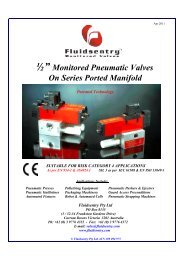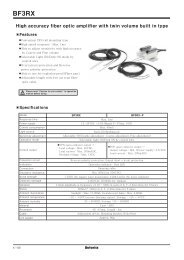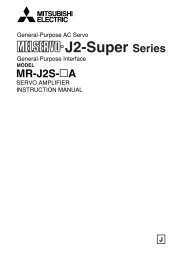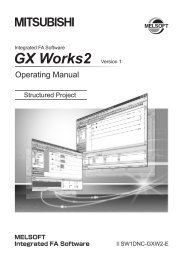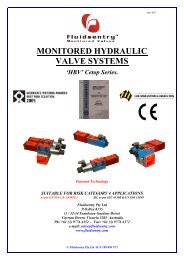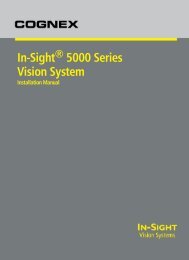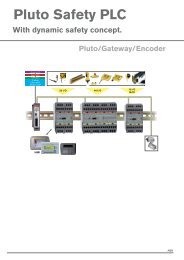- Page 1 and 2:
INVERTERFR-A701INSTRUCTION MANUAL (
- Page 3 and 4:
CONTENTS1 OUTLINE 11.1 Product chec
- Page 5 and 6:
4.6.4 Setting of the electronic gea
- Page 7 and 8:
4.18.4 Overspeed detection (Pr. 374
- Page 9 and 10:
5.5.5 Motor rotates in opposite dir
- Page 11 and 12:
MEMO
- Page 13 and 14:
Product checking and parts identifi
- Page 15 and 16:
Inverter and peripheral devices1.2.
- Page 17 and 18:
Method of removal and reinstallatio
- Page 19 and 20:
Installation of the inverter and en
- Page 21 and 22:
Installation of the inverter and en
- Page 23 and 24:
Installation of the inverter and en
- Page 25 and 26:
Terminal connection diagram2.1 Term
- Page 27 and 28:
Main circuit terminal specification
- Page 29 and 30:
Main circuit terminal specification
- Page 31 and 32:
Main circuit terminal specification
- Page 33 and 34:
Control circuit specifications2.3 C
- Page 35 and 36:
Control circuit specifications(2) O
- Page 37 and 38:
Control circuit specifications4)Sin
- Page 39 and 40:
Control circuit specifications2.3.4
- Page 41 and 42:
Connection of motor with encoder (v
- Page 43 and 44:
Connection of motor with encoder (v
- Page 45 and 46:
Connection of motor with encoder (v
- Page 47 and 48:
Connection of motor with encoder (v
- Page 49 and 50:
EMC and leakage currents3.1 EMC and
- Page 51 and 52:
EMC and leakage currents3.1.2 EMC m
- Page 53 and 54:
EMC and leakage currents3.1.3 Power
- Page 55 and 56:
Power-off and magnetic contactor (M
- Page 57 and 58:
Precautions for use of the inverter
- Page 59 and 60:
Failsafe of the system which uses t
- Page 61 and 62:
MEMO50
- Page 63 and 64:
Operation panel (FR-DU07)4.1 Operat
- Page 65 and 66:
Operation panel (FR-DU07)4.1.3 Chan
- Page 67 and 68:
Parameter listParameter ListFunctio
- Page 69 and 70:
Parameter listParameter ListFunctio
- Page 71 and 72:
Parameter listFunctionParameter Nam
- Page 73 and 74:
Parameter listParameter ListFunctio
- Page 75 and 76:
Parameter listFunctionParameter Nam
- Page 77 and 78:
Parameter listParameter ListFunctio
- Page 79 and 80:
Parameters according to purposes4.3
- Page 81 and 82:
4.21.4 Response level of analog inp
- Page 83 and 84:
Control mode4.3.1 What is vector co
- Page 85 and 86:
Control mode(1) Speed controlSpeed
- Page 87 and 88:
Control mode(3) Vector control test
- Page 89 and 90:
Control mode• Terminal 4 function
- Page 91 and 92:
Speed control by real sensorless ve
- Page 93 and 94:
Speed control by real sensorless ve
- Page 95 and 96:
Speed control by real sensorless ve
- Page 98 and 99:
4PARAMETERSSpeed control by real se
- Page 100 and 101:
4PARAMETERSSpeed control by real se
- Page 102 and 103:
4PARAMETERS(5) Manual input speed c
- Page 104 and 105:
4PARAMETERSSpeed control by real se
- Page 106 and 107:
4PARAMETERSSpeed control by real se
- Page 108 and 109:
4PARAMETERSSpeed control by real se
- Page 110 and 111:
4PARAMETERS(4) Setting torque bias
- Page 112 and 113:
4PARAMETERSSpeed control by real se
- Page 114 and 115:
4PARAMETERSTorque control by real s
- Page 116 and 117:
4PARAMETERS(3) Operation example (w
- Page 118 and 119:
4PARAMETERSTorque control by real s
- Page 120 and 121:
4PARAMETERS(3) Torque command using
- Page 122 and 123:
4PARAMETERSTorque control by real s
- Page 124 and 125:
4PARAMETERSTorque control by real s
- Page 126 and 127:
4PARAMETERSPosition control by vect
- Page 128 and 129:
4PARAMETERSPosition control by vect
- Page 130 and 131:
4PARAMETERS(1) Setting of position
- Page 132 and 133:
4PARAMETERS(3) Selection of clear s
- Page 134 and 135:
4PARAMETERSPosition control by vect
- Page 136 and 137:
4PARAMETERSPosition control by vect
- Page 138 and 139:
4PARAMETERSAdjustment of real senso
- Page 140 and 141:
4PARAMETERSAdjust the output torque
- Page 142 and 143:
4PARAMETERSAdjust the output torque
- Page 144 and 145:
4PARAMETERSAdjust the output torque
- Page 146 and 147:
4PARAMETERSAdjust the output torque
- Page 148 and 149:
4PARAMETERSAdjust the output torque
- Page 150 and 151:
4PARAMETERSAdjust the output torque
- Page 152 and 153:
4PARAMETERSLimit the output frequen
- Page 154 and 155:
4PARAMETERS(3) Base frequency volta
- Page 156 and 157:
4PARAMETERSSet V/F patternPr. 14Set
- Page 158 and 159:
4PARAMETERS4.10.4 Adjustable 5 poin
- Page 160 and 161:
4PARAMETERSFrequency setting by ext
- Page 162 and 163:
4PARAMETERSFrequency setting by ext
- Page 164 and 165:
4PARAMETERSFrequency setting by ext
- Page 166 and 167:
4PARAMETERS4.12 Setting of accelera
- Page 168 and 169:
4PARAMETERSSetting of acceleration/
- Page 170 and 171:
4PARAMETERSSetting of acceleration/
- Page 172 and 173:
4PARAMETERSSetting of acceleration/
- Page 174 and 175:
4PARAMETERS(2) Optimum acceleration
- Page 176 and 177:
4PARAMETERS4.13 Selection and prote
- Page 178 and 179:
4PARAMETERSSelection and protection
- Page 180 and 181:
4PARAMETERS4.13.2 Applied motor (Pr
- Page 182 and 183:
4PARAMETERSSelection and protection
- Page 184 and 185:
4PARAMETERSSelection and protection
- Page 186 and 187:
4PARAMETERSSelection and protection
- Page 188 and 189:
4PARAMETERSSelection and protection
- Page 190 and 191:
4PARAMETERSSelection and protection
- Page 192 and 193:
4PARAMETERSSelection and protection
- Page 194 and 195:
4PARAMETERSSelection and protection
- Page 196 and 197:
4PARAMETERSMotor brake and stop ope
- Page 198 and 199:
4PARAMETERS(5) Brake operation sele
- Page 200 and 201:
4PARAMETERSMotor brake and stop ope
- Page 202 and 203:
4PARAMETERSMotor brake and stop ope
- Page 204 and 205:
4PARAMETERSMotor brake and stop ope
- Page 206 and 207:
4PARAMETERSMotor brake and stop ope
- Page 208 and 209:
4PARAMETERSMotor brake and stop ope
- Page 210 and 211:
4PARAMETERSMotor brake and stop ope
- Page 212 and 213:
4PARAMETERSMotor brake and stop ope
- Page 214 and 215:
4PARAMETERS• Position loop gain (
- Page 216 and 217:
4PARAMETERS• Pr. 399 Orientation
- Page 218 and 219:
4PARAMETERSFunction assignment of e
- Page 220 and 221:
4PARAMETERS4.15.2 Inverter output s
- Page 222 and 223:
4PARAMETERSFunction assignment of e
- Page 224 and 225:
4PARAMETERS4.15.5 Magnetic flux dec
- Page 226 and 227:
4PARAMETERSFunction assignment of e
- Page 228 and 229:
4PARAMETERSFunction assignment of e
- Page 230 and 231:
4PARAMETERS(3) Forward rotation and
- Page 232 and 233:
4PARAMETERSFunction assignment of e
- Page 234 and 235:
4PARAMETERS4.15.8 Output current de
- Page 236 and 237:
4PARAMETERS4.15.10 Remote output fu
- Page 238 and 239:
4PARAMETERSMonitor display and moni
- Page 240 and 241:
4PARAMETERSMonitor display and moni
- Page 242 and 243:
4PARAMETERSMonitor display and moni
- Page 244 and 245:
4PARAMETERSMonitor display and moni
- Page 246 and 247:
4PARAMETERSMonitor display and moni
- Page 248 and 249:
4PARAMETERSMonitor display and moni
- Page 250 and 251:
4PARAMETERSOperation selection at p
- Page 252 and 253:
4PARAMETERSOperation selection at p
- Page 254 and 255:
4PARAMETERSOperation selection at p
- Page 256 and 257:
4PARAMETERS(6) Power failure decele
- Page 258 and 259:
4PARAMETERS⋅⋅⋅⋅Operation se
- Page 260 and 261:
4PARAMETERS4.18.3 Input/output phas
- Page 262 and 263:
4PARAMETERSEnergy saving operation
- Page 264 and 265:
4PARAMETERSEnergy saving operation
- Page 266 and 267:
4PARAMETERSEnergy saving operation
- Page 268 and 269:
4PARAMETERSMotor noise, EMI measure
- Page 270 and 271:
4PARAMETERSFrequency/torque setting
- Page 272 and 273:
4PARAMETERSFrequency/torque setting
- Page 274 and 275:
4PARAMETERSFrequency/torque setting
- Page 276 and 277:
4PARAMETERS4.21.4 Response level of
- Page 278 and 279:
4PARAMETERSFrequency/torque setting
- Page 280 and 281:
4PARAMETERSFrequency/torque setting
- Page 282 and 283:
4PARAMETERSFrequency/torque setting
- Page 284 and 285:
4PARAMETERSFrequency/torque setting
- Page 286 and 287:
4PARAMETERS(6) Adjustment method of
- Page 288 and 289:
4PARAMETERSc) Method to adjust torq
- Page 290 and 291:
4PARAMETERS(2) Disconnected PU dete
- Page 292 and 293:
4PARAMETERS4.22.3 Reverse rotation
- Page 294 and 295:
4PARAMETERSSelection of operation m
- Page 296 and 297: 4PARAMETERSSelection of operation m
- Page 298 and 299: 4PARAMETERS(6) PU/external combined
- Page 300 and 301: 4PARAMETERS(10) Switching of operat
- Page 302 and 303: 4PARAMETERS4.23.2 Operation mode at
- Page 304 and 305: 4PARAMETERSSelection of operation m
- Page 306 and 307: 4PARAMETERSSelection of operation m
- Page 308 and 309: 4PARAMETERS4.24 Communication opera
- Page 310 and 311: 4PARAMETERS4.24.2 Wiring and arrang
- Page 312 and 313: 4PARAMETERSCommunication operation
- Page 314 and 315: 4PARAMETERSCommunication operation
- Page 316 and 317: 4PARAMETERSCommunication operation
- Page 318 and 319: 4PARAMETERSCommunication operation
- Page 320 and 321: 4PARAMETERS(8) Instructions for the
- Page 322 and 323: 4PARAMETERS(9) Setting items and se
- Page 324 and 325: 4PARAMETERSCommunication operation
- Page 326 and 327: 4PARAMETERSCommunication operation
- Page 328 and 329: 4PARAMETERSCommunication operation
- Page 330 and 331: 4PARAMETERS(5) Message format types
- Page 332 and 333: 4PARAMETERSCommunication operation
- Page 334 and 335: 4PARAMETERSCommunication operation
- Page 336 and 337: 4PARAMETERSCommunication operation
- Page 338 and 339: 4PARAMETERSCommunication operation
- Page 340 and 341: 4PARAMETERS4.25 Special operation a
- Page 342 and 343: 4PARAMETERSSpecial operation and fr
- Page 344 and 345: 4PARAMETERSSpecial operation and fr
- Page 348 and 349: 4PARAMETERSSpecial operation and fr
- Page 350 and 351: 4PARAMETERSSpecial operation and fr
- Page 352 and 353: 4PARAMETERSSpecial operation and fr
- Page 354 and 355: 4PARAMETERS(1) Load torque high spe
- Page 356 and 357: 4PARAMETERS(2) Limit the frequency
- Page 358 and 359: 4PARAMETERSSpecial operation and fr
- Page 360 and 361: 4PARAMETERSSpecial operation and fr
- Page 362 and 363: 4PARAMETERS4.25.7 Regeneration avoi
- Page 364 and 365: 4PARAMETERSUseful functions4.26 Use
- Page 366 and 367: 4PARAMETERS(1) Life alarm display a
- Page 368 and 369: 4PARAMETERSUseful functions4.26.3 M
- Page 370 and 371: 4PARAMETERSUseful functions(3) Sett
- Page 372 and 373: 4PARAMETERSSetting of the parameter
- Page 374 and 375: 4PARAMETERSSetting of the parameter
- Page 376 and 377: 4PARAMETERSAll parameter clear4.29
- Page 378 and 379: 4PARAMETERSParameter copy and param
- Page 380 and 381: 4PARAMETERSCheck and clear of the f
- Page 382 and 383: 5 PROTECTIVE FUNCTIONSThis chapter
- Page 384 and 385: List of fault or alarm display5.2 L
- Page 386 and 387: Causes and corrective actionsOperat
- Page 388 and 389: Causes and corrective actionsOperat
- Page 390 and 391: Causes and corrective actionsOperat
- Page 392 and 393: Causes and corrective actionsOperat
- Page 394 and 395: Causes and corrective actionsOperat
- Page 396 and 397:
Causes and corrective actionsOperat
- Page 398 and 399:
Causes and corrective actionsOperat
- Page 400 and 401:
Correspondences between digital and
- Page 402 and 403:
Check first when you have troubles5
- Page 404 and 405:
6 PRECAUTIONS FORMAINTENANCE AND IN
- Page 406 and 407:
Inspection item6.1.3 Daily and peri
- Page 408 and 409:
Inspection item6.1.6 CleaningAlways
- Page 410 and 411:
(2) Smoothing capacitorsInspection
- Page 412 and 413:
Measurement of main circuit voltage
- Page 414 and 415:
Measurement of main circuit voltage
- Page 416 and 417:
7 SPECIFICATIONSThis chapter provid
- Page 418 and 419:
Rating•400V classType FR-A741-K 5
- Page 420 and 421:
Common specifications7.2 Common spe
- Page 422 and 423:
Outline dimension drawings•FR-A72
- Page 424 and 425:
Outline dimension drawings•FR-A72
- Page 426 and 427:
Outline dimension drawings7.3.2 Ded
- Page 428 and 429:
Outline dimension drawings• Dedic
- Page 430 and 431:
Installation of the heatsink portio
- Page 432 and 433:
APPENDICESThis chapter provides the
- Page 434 and 435:
Appendix 2 Control mode-based param
- Page 436 and 437:
ParameterNameInstructionCode * 1Rea
- Page 438 and 439:
ParameterNameInstructionCode * 1Rea
- Page 440 and 441:
ParameterNameInstructionCode * 1Rea
- Page 442 and 443:
ParameterNameInstructionCode * 1Rea
- Page 444 and 445:
Parameter423NamePosition feed forwa
- Page 446 and 447:
Parameter500NameInstructionCode * 1
- Page 448 and 449:
ParameterNameInstructionCode * 1Rea
- Page 450 and 451:
ParameterC16(919)C17(919)C18(920)C1



